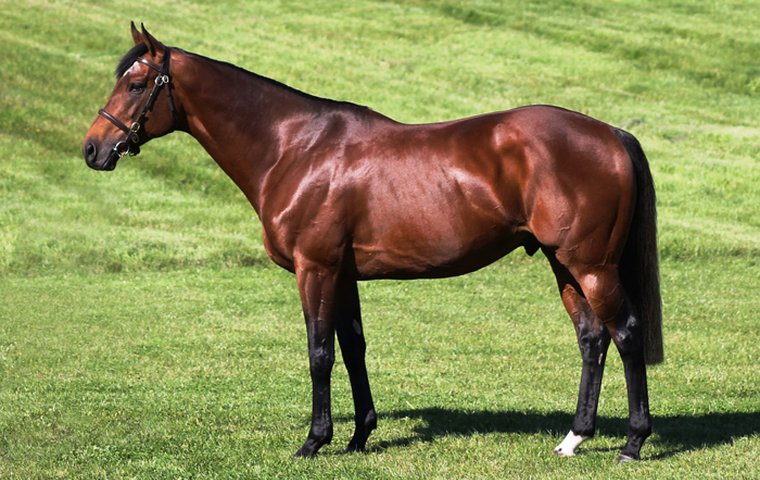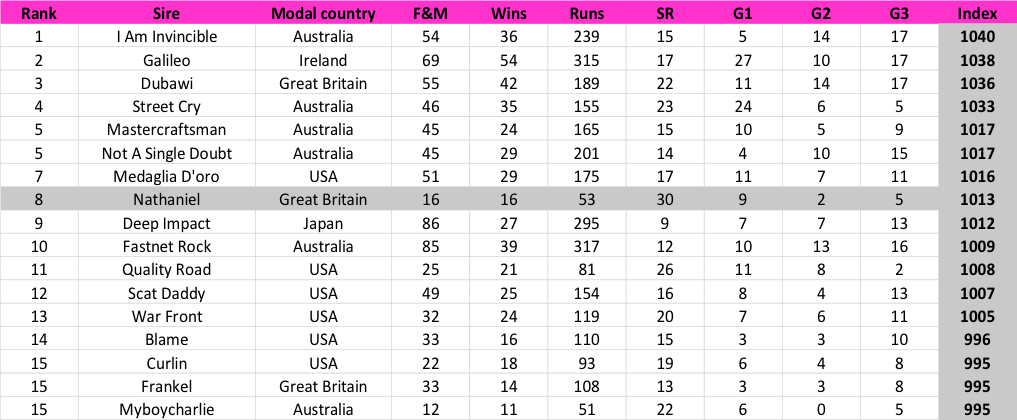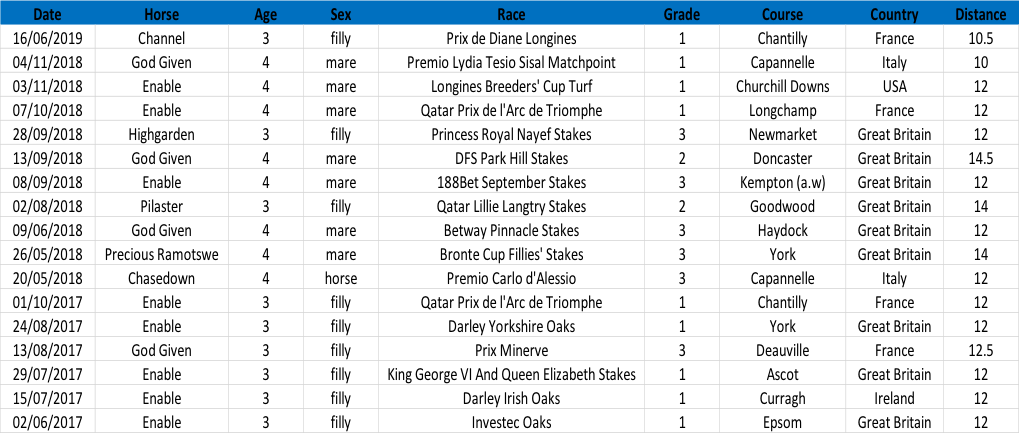
The result of the Prix de Diane Longines at Chantilly on Sunday illustrates once again a cold, hard fact about pedigrees, James Willoughby argues.
TRC SIRE OF THE WEEK
Computer power enables the modern sports analyst to review past events from a certain perspective. In terms of TRC Global Rankings, we can ask a number of interesting questions about the data provided by the world’s most important races in order to highlight new trends.
Channel’s victory in the G1 Prix de Diane Longines provided the impetus for one such question: what would be the ranking of the world’s top stallions if only fillies and mares counted towards the results. Here is the answer:

A reminder here of some of the elements that drive Index, shown in the main tables as ‘Points’. The key is always to make the best predictions for future competition, so TRC Global Rankings continue to measure something real – as opposed to other ranking systems, which are more arbitrary in their allocation of points or merely just an exercise in playing with numbers.
We will get to Nathaniel in a second. But, first a note as to why I Am Invincible ranks #1.
Allowing for the quality of the opposition, his fillies and mares have the best head-to-head record of any stallion in the world, weighted by recency and giving more credit to stallions with more different individuals in their portfolio. (All these factors are controlled by coefficients that change automatically across time as results accumulate.)
In fact, in head-to-head competition against all the other sires with Modal Country ‘Australia’ listed in the table above, I Am Invincible is 144-118 (55%). We weight these head-to-heads by their significance and predictive power to arrive at the final value of Index.
By contrast, Galileo’s fillies and mares are 62-82 (43%) against Dubawi’s alone. The outstanding Galileo has a huge edge in terms of volume, making it nonetheless preferable to the algorithm currently to side with Galileo’s fillies in clashes with Dubawi’s. Every value of our points score Index which drives the rankings in a giant global network of interdependencies. Then the same rankings maths used in search engines and recommender systems is used to solve for the final order.
So, finally to NATHANIEL (+3pts, #28 from #31). The son of Galileo ranks much higher (#8) in this study of fillies and mares than in the main rankings simply because the preponderance of his winners has been female runners, led by the dual Arc heroine Enable, of course.
But, the pride of Klaus Jacobs’ Newsells Park Stud is no one-trick pony. Among his 17 Group winners, contributions have been made by God Given and Highgarden, Precious Ramotswe and Pilaster. These winners all stay well and, remarkably, are all female. Only the Italian G3 winner Chasedown has made a contribution among the males.
Pedigree analysts in horse racing seem very fond of making inferences from small samples. One could argue that this has to be their preoccupation in order to catch the latest trends in a fast-moving environment. But the vast majority of so-called ‘nicks’ (apparently prepotent combinations of sire and damsire, for example) turn out to be no more than noise. And the ones that persist (such as Galileo out of a Danehill-line stallion) are really a function of good-on-good made possible because they are an outcross.
The same thing usually happens when it is assumed a stallion’s results are sex-linked. Nathaniel’s 17 Group wins is a tiny sample. Yes, one could express that the distribution is very unlikely to have happened randomly in terms of binomial (‘coin toss’) probability. But this is probably misleading. Across all stallions with only 17 Group wins so far, we would not find many with a horse as good as Enable who accounted for eight of them.
The fact that TRC Global Rankings has Nathaniel ranked #8 on the basis of just fillies and mares and #28 overall is not us saying that we think he is likely to produce more good distaffers than males in future. Our rankings (a probability estimate of a win next week, remember) have to account for the horses running around at present. And Nathaniel happens to have produced more of those who are female than male.
Nathaniel was a top-class racehorse (he won the G1 King George at Ascot and the G1 Coral-Eclipse at Sandown in separate seasons) with a tip-top middle-distance pedigree. In common with every stallion with these credentials, he is very likely to produce very good runners if granted the mares of sufficient quality. Just look at the upper echelon of our sires ranking; it is dominated by stallions who exhibited strong stamina for a good reason – this works.
This is beautifully expressed in Nancy Sexton’s excellent article on Japanese breeding, which is a must-read for people who really care about the future of this sport.
Breeding from solid, strong-running stock, rather than flimsy juveniles who were one-hit wonders, isn’t just to allow tradition to persist. It has always been a better policy; it will always be a better policy. Because a measure of stamina is needed at all distances, which the great Italian breeder Federico Tesio stressed in his writing. Speed and stamina are not discrete entities. Rather, they are two sides of the same coin.
In general, if you know nothing else about two racehorses, the one who stays better is better. Stamina is sustained pace; speed is nothing without the capacity to endure. Sure, there is a limit to this rule of thumb. Horses who need very long distances are competing in a sub-class of runners and probably don’t need to be as special as the mile and a half runner on grass or the ten-furlong animal on dirt.
TRC Global Rankings express real-life probabilities of winning. And, when you look at the stallions who come out the best around the world, they were generally best at distances beyond a mile. It is not a coincidence.
Whether Nathaniel ever joins the truly elite depends on whether humans are smart enough to use stallions who are an influence for stamina with greater frequency than is the case right row. If, by some miracle, the folly is reversed, this is a stallion waiting to deliver more runners with the brilliant, brilliant ability of Enables. Including colts, as Dashing Willoughby’s win in the G2 Queen’s Vase at Royal Ascot was to show on Wednesday. (That results will not be included in the TRC Global Rankings until next week.)

Click here for a list of all last week’s biggest TRC Global Rankings points gainers
Click here for a list of all the week’s Group and Graded winners


